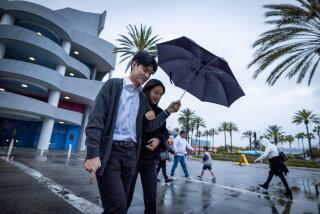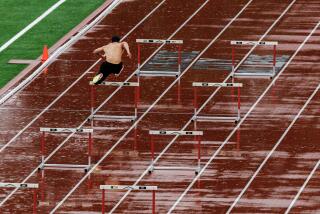California storms did little to ease drought conditions
The storms that slammed Southern California dumped much needed rain, but experts said they did little to ease the drought conditions.
“This is no drought-buster, but it’s a nice, fat down payment” in the water bank, said Bill Patzert, a climatologist for the Jet Propulsion Laboratory in La Cañada Flintridge.
Patzert said the latest storm, the largest since December 2010, helped put an end to an unusually long wildfire season and to ease the three-year drought conditions plaguing the state. He said it would bring the Los Angeles region to about half its normal rainfall for the season; it started the week at just 10% of normal.
Gov. Jerry Brown on Saturday signed legislation to free up the state’s water supplies and to help residents who face hardship because of the drought. Also, parched Sierra Nevada ski resorts got a dose of snow, enabling them to open some previously bare runs and adding to the severely low snowpack, a major source of the state’s water.
As Saturday evening, the storm had dropped over 3 inches of rain in downtown Los Angeles, over 4 inches in Van Nuys and over 10 inches at Cogswell Dam in the Angeles National Forest, according to the National Weather Service.
“We said it was going to be a strong storm, and it was. There was some very intense rain,” said Bonnie Bartling, a weather specialist with the National Weather Service in Oxnard.
Although the main storm band is gone, showers will continue off and on, with a slight chance of thunderstorms, until Sunday afternoon, Bartling said. More snow is also expected to fall in the mountains.
The storm brought its share of misery in the suburban foothills of Glendora, Azusa and Monrovia, below wildfire-denuded sections of the San Gabriel Mountains.
The hills behind Ridge View Drive in Azusa were swollen with mud, threatening to damage the same homes that survived the 2,000-acre Colby fire less than two months ago.
Rain earlier in the week had sent mud coursing toward the backyards of homes nestled against the hills. Los Angeles County firefighters parked in the cul-de-sac, with heavy equipment waiting nearby, just in case.
Resident Ed Heinlein, who evacuated early Friday with five family members, returned Saturday morning to rescue Gizmo, the family cat.
“When we drove up, we knew it was going to be bad,” Heinlein said. On Friday, he said, a little mud had been strewn in the street. On Saturday, there was a lot more debris, much of it coming from his own lot.
During about 20 minutes of hard rain Saturday morning, he said, a wave of mud had rolled down the mountain, surged over a retaining wall and buried his backyard. The force of the mud bent a metal fence at a 45-degree angle. Only the net and backboard of his 10-foot-high basketball hoop were visible above the muck.
“We’ve got to find a way to get the 100 tons of mud out of my backyard,” Heinlein said. “We’re probably looking at tens of thousands of dollars in damage.”
Insurance won’t cover the damage to his home, Heinlein said -- a risk the family took when they moved into the home more than 11 years ago.
“It’s a beautiful area,” Heinlein said, as heavy clouds hugged the rough hills behind him. “But if you’re going to live in an area that has these types of mountains and these types of fires, you know what can happen.”
Jeff White’s home wasn’t damaged, but he came back to the neighborhood Saturday to grab clothes from the house and check on his neighbors. He walked gingerly through the mud on the terraces, looking at avocado trees and shrubbery buried in silt.
“We evacuated in January, we evacuated in February,” said White, whose home is across the street from the mountains. “We’re just hoping March will be better.”
Elsewhere in the L.A. Basin, officials braced for high winds, wild surf, thunderstorms and even some tornadoes.
In downtown Los Angeles, a large hole swallowed a chunk of street in the 200 block of North Broadway, officials said. The hole was about 4 feet by 8 feet in diameter and about 10 feet deep, according to the Los Angeles Fire Department.
Maintenance crews were called out to assess and try to fix the damage while police officers directed traffic.
About 3,200 households in the city of Los Angeles and an additional 2,400 countywide went without electricity, mostly because of debris falling on power lines. In Riverside, about 21,000 customers had their power knocked out by lightning strikes.
Saturday evening, the 110 Freeway was closed at the 405 Freeway in Carson because of flooding. On the Central Coast, a pier at Gaviota State Park collapsed after being buffeted by large waves.
But overall, Patzert said, things were turning out pretty well.
“The urban flooding here, except in some of the burn areas,” he said, “really has been pretty minimal.”
More to Read
Sign up for Essential California
The most important California stories and recommendations in your inbox every morning.
You may occasionally receive promotional content from the Los Angeles Times.













